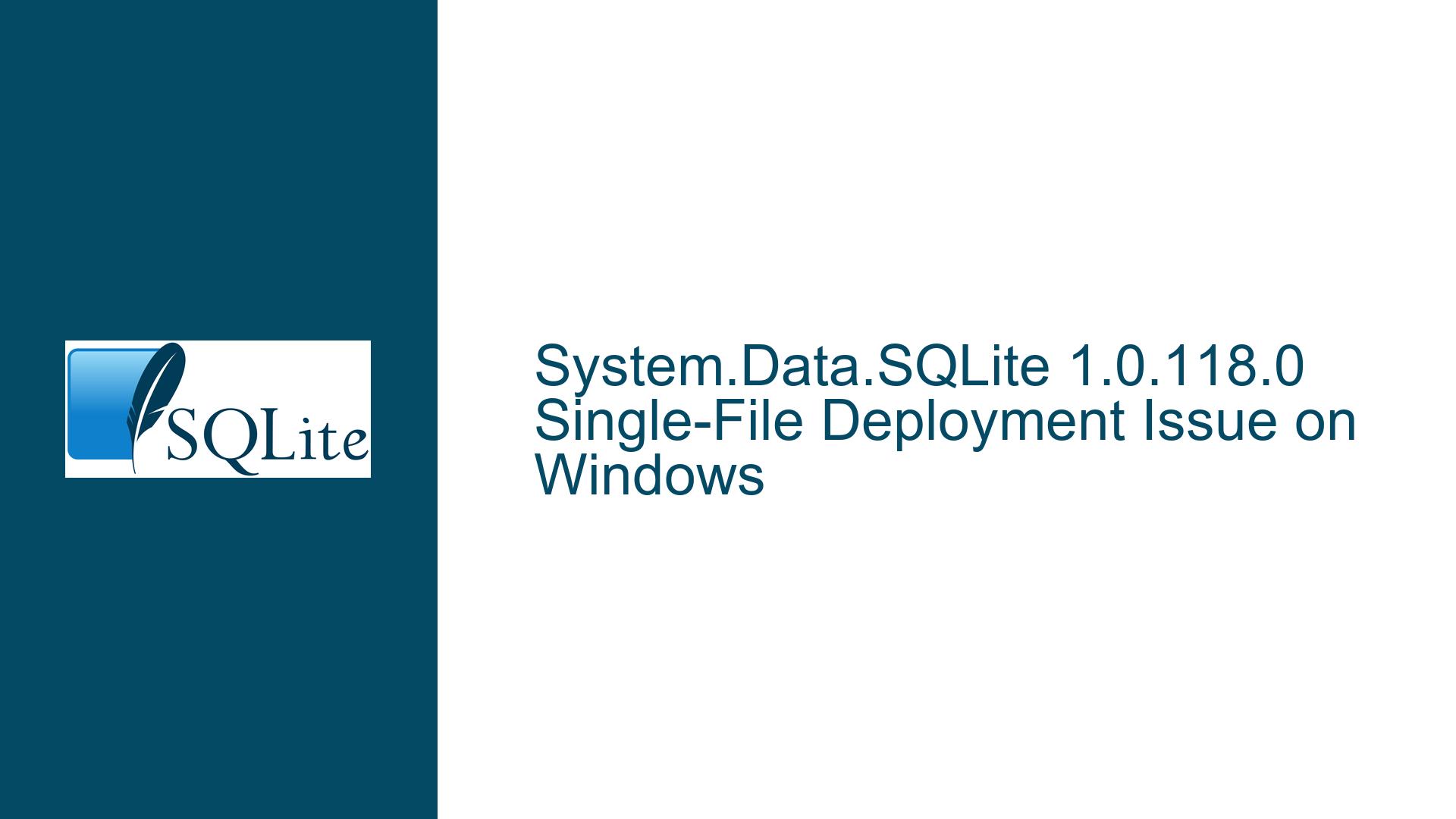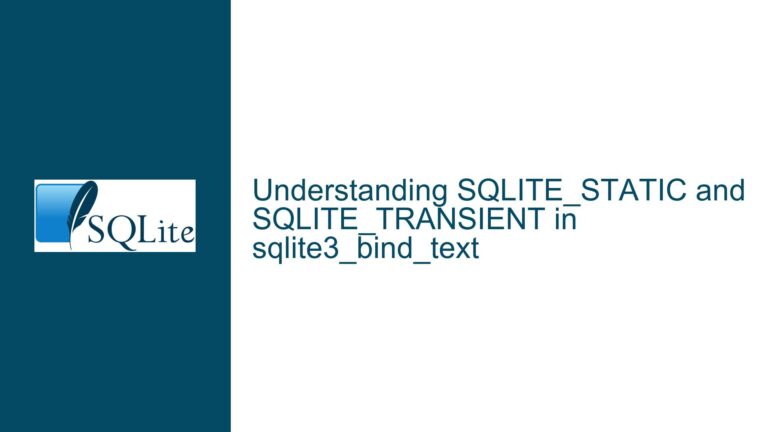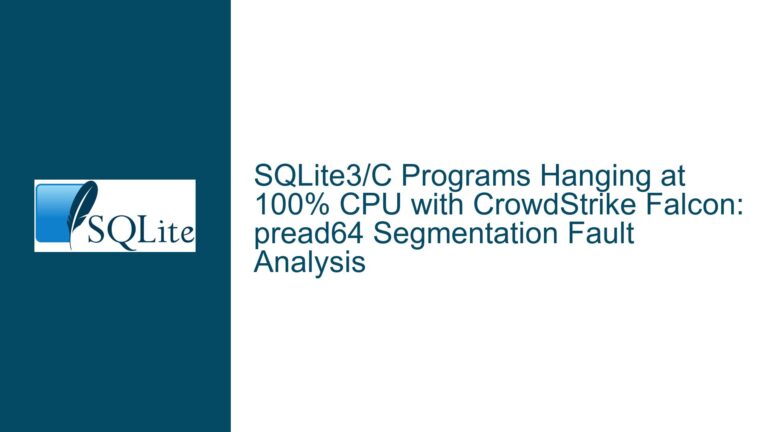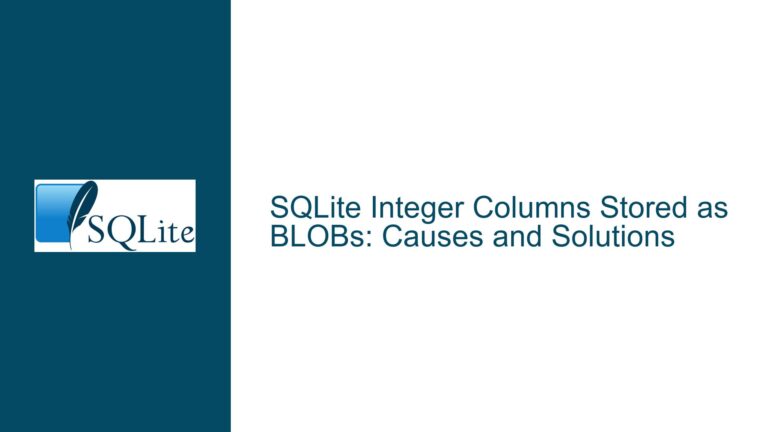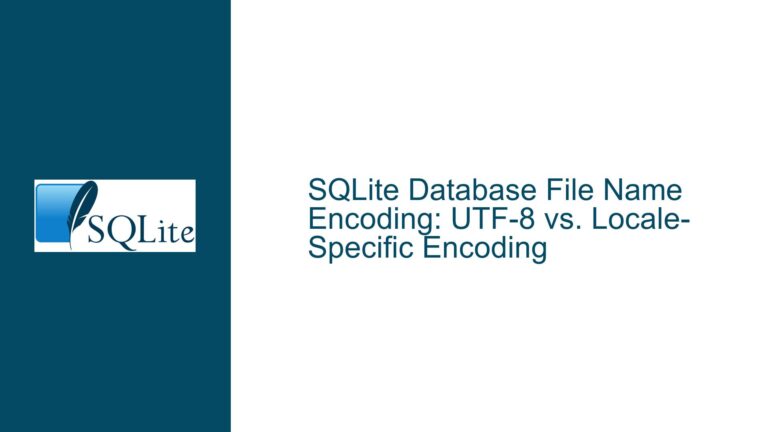System.Data.SQLite 1.0.118.0 Single-File Deployment Issue on Windows
Issue Overview: System.Data.SQLite 1.0.118.0 Fails on Windows with Single-File Deployment
The core issue revolves around the System.Data.SQLite library version 1.0.118.0, which introduces a critical bug when used in single-file deployment scenarios on Windows. Specifically, when the -p:PublishSingleFile=true option is enabled during the build process, the application throws an System.ArgumentNullException with the message "Value cannot be null. (Parameter ‘path1’)". This exception occurs during the instantiation of the SQLiteConnection object, preventing the application from establishing a connection to the SQLite database.
The issue is isolated to Windows environments and does not manifest on Linux, even when using single-file deployments. Additionally, the problem is absent when the application is built without the single-file deployment option. This suggests that the issue is tied to how the System.Data.SQLite library handles file paths and resource loading in single-file deployment contexts on Windows.
The error trace points to the System.IO.Path.Combine method, which is called internally by the SQLiteConnection constructor. The path1 parameter being passed to this method is null, leading to the exception. This behavior is not observed in previous versions of the library (1.0.117.0 and 1.0.116.0), which work correctly across all deployment types and operating systems.
Possible Causes: Path Resolution and Resource Loading in Single-File Deployments
The root cause of the issue appears to be related to how the System.Data.SQLite library resolves file paths and loads resources when the application is packaged as a single executable file. Single-file deployment is a feature in .NET that bundles all application dependencies, including native libraries and configuration files, into a single executable. This bundling process can alter the way file paths are resolved at runtime, especially when accessing embedded resources or external files.
In the case of System.Data.SQLite 1.0.118.0, the library attempts to combine paths for internal configuration or resource loading, but one of the paths is unexpectedly null. This could be due to one of the following reasons:
Incorrect Handling of Embedded Resources: The library may be attempting to access a configuration file or resource that is embedded within the single executable but fails to resolve its path correctly. This could be due to changes in how embedded resources are accessed in single-file deployments.
Environment-Specific Path Resolution: The library might rely on environment-specific path resolution logic that behaves differently on Windows compared to Linux. For example, Windows uses backslashes (
\) as path separators, while Linux uses forward slashes (/). If the library’s path resolution logic is not robust enough to handle these differences, it could lead to null paths.Changes in the .NET Runtime: The issue could be related to changes in the .NET runtime’s handling of single-file deployments. System.Data.SQLite 1.0.118.0 might be relying on runtime behavior that has changed in recent .NET versions, leading to unexpected null values in path resolution.
Library Initialization Order: The library might be initializing certain components before the necessary environment variables or configuration settings are available. This could result in null values being passed to internal methods that expect valid paths.
Troubleshooting Steps, Solutions & Fixes: Workarounds and Long-Term Solutions
Immediate Workaround: Setting the SQLite_NoConfigure Environment Variable
A temporary workaround for this issue is to set the SQLite_NoConfigure environment variable to any value (e.g., "1"). This environment variable disables certain configuration steps within the System.Data.SQLite library, preventing the path resolution issue from occurring. There are several ways to set this environment variable:
Manually via Command Prompt: Users can set the environment variable manually by running the following command in a Command Prompt window before launching the application:
set SQLite_NoConfigure=1This sets the environment variable for the current session. To verify that the variable has been set, users can run:
set SQLite_NoConfigureThis will display the value of the variable if it has been set correctly.
Programmatically in the Application: Developers can set the environment variable programmatically at the start of their application. For example, in a .NET application, the following code can be added to the
Mainmethod or application initialization logic:System.Environment.SetEnvironmentVariable("SQLite_NoConfigure", "1");This approach ensures that the environment variable is set before any SQLite-related code is executed, eliminating the need for manual intervention by end-users.
Via Application Configuration: For applications that use configuration files, the environment variable can be set in the application’s launch settings or configuration file. This method is particularly useful for containerized or cloud-based deployments where environment variables are commonly used for configuration.
While this workaround resolves the immediate issue, it is important to note that it disables certain configuration steps within the library. This could potentially affect other functionality, although no specific issues have been reported so far.
Long-Term Solution: Library Update and Code Fixes
The most robust solution to this issue is to wait for an updated version of the System.Data.SQLite library that addresses the path resolution problem. The library maintainers have acknowledged the issue and are likely working on a fix for the next release (presumably version 1.0.119.0). Developers should monitor the official System.Data.SQLite website and release notes for updates.
In the meantime, developers can consider the following steps to mitigate the issue and prepare for the eventual fix:
Stay on Version 1.0.117.0: If the new features or fixes in version 1.0.118.0 are not critical for your application, consider staying on version 1.0.117.0, which does not exhibit this issue. This is the simplest and most reliable solution for applications that do not require the specific changes introduced in 1.0.118.0.
Implement Conditional Logic: For applications that must use version 1.0.118.0, consider implementing conditional logic to handle single-file deployments differently. For example, you could detect whether the application is running in a single-file deployment context and apply the
SQLite_NoConfigureworkaround only in those cases. This approach minimizes the impact of the workaround on other deployment scenarios.Contribute to the Fix: If you have the resources and expertise, consider contributing to the System.Data.SQLite project by identifying the exact cause of the issue and proposing a fix. The project is open-source, and contributions from the community are welcome. This could involve debugging the library’s path resolution logic and submitting a pull request with the necessary changes.
Monitor Community Feedback: Keep an eye on community forums and discussion threads for updates on the issue. Other developers may share additional workarounds or insights that could help mitigate the problem until an official fix is released.
Testing and Validation
Regardless of the chosen solution, thorough testing is essential to ensure that the issue is fully resolved and that no new issues are introduced. Here are some recommended testing steps:
Single-File Deployment Testing: Test the application in single-file deployment mode on both Windows and Linux to verify that the issue is resolved and that no new issues arise.
Environment Variable Testing: If using the
SQLite_NoConfigureworkaround, test the application with the environment variable set and unset to ensure that the workaround does not introduce any side effects.Path Resolution Testing: Test the application with various database file paths, including relative paths, absolute paths, and paths with special characters, to ensure that path resolution works correctly in all scenarios.
Performance Testing: Monitor the application’s performance and resource usage to ensure that the workaround or fix does not negatively impact performance.
By following these steps, developers can effectively address the System.Data.SQLite 1.0.118.0 single-file deployment issue on Windows and ensure a smooth user experience.
